Getting comfortable in the Spotlight
September 13, 2012
How do you get to the Spotlight Awards? Practice—and a free, daylong workshop created by the Music Center to introduce prospective students, parents and teachers to the prestigious program.
Jeri Gaile, who has directed the Spotlight program for the past 11 years, hopes the Sept. 30 workshop called “Spotlight Academy” will help ease fears of competition and auditioning.
“This is all a big, warm fuzzy,” said Gaile. “We’re somewhere in between dancing for grandma and auditioning for Juilliard.”
Of course, the young performers aren’t the only ones with the jitters. Gaile also wants to ease the minds of parents who might be concerned about their kids’ future job prospects.
“There are lots of wonderful careers that may not have to do with performing,” she said. “We want to make parents less afraid about their kids seeking careers in the arts.”
In addition to providing information about the Spotlight competition, now in its 25th year, the workshop will teach practical strategies for applying to college music programs, working with agents and getting gigs. Attendees have the option to attend classes on topics such as “how to deal with nerves” and “singing from the heart.”
After the workshop, there will be plenty of time to for students to decide if they want to sign up for the free competition—the registration deadline for performance artists is October 17, and visual artists have until December 1. Categories of performance art include ballet, non-classical dance, classical voice, non-classical voice, classical instrumental and jazz instrumental. Visual artists can compete in two-dimensional art or photography.
More than 3,000 students compete in Spotlight annually. After the initial round of evaluations, 15 semifinalists are selected from each category to move on to the next round and attend “master classes.” All judging and teaching is done by top-notch professionals and university-level faculty members.
After the second round of evaluations, two students in each category proceed to the final, public round in the Dorothy Chandler Pavilion. Semifinalists in visual arts get their own gallery exhibition, classes and museum tours. All who make it to the semifinals share in more than $100,000 in scholarships.
To reserve a spot at the workshop, email names of participants to [email protected]. The workshop will be held from 9:30 a.m. to 4 p.m. on Sunday, September 30.
Posted 9/13/12
What’s on TAP? For some, confusion
September 13, 2012
All Brandon Crosby wanted was to hop aboard the Red Line subway and travel one stop—from Hollywood/Highland to Hollywood/Vine—to get to the box office at the Pantages Theatre.
But for Crosby, the journey of a single stop began with a thousand questions.
Standing at a bank of Metro ticket vending machines Tuesday afternoon, Crosby was flummoxed and increasingly exasperated as he tried to figure out how to buy a ticket to get him to the theater and back. The machine was offering him no choice but to buy something he didn’t see why he needed—a $1 plastic TAP card—along with his regular fare. And where was the round trip option? Then, when he pushed the “help” button, he got even more confused when the machine told him that his preferred purchase—a paper ticket for one-time use—was available, when in fact it was not.
“It makes no sense to me,” said Crosby, an L.A. resident who usually drives but wanted to give the subway a try for what he thought would be a quick jaunt. “I hate it.”
He’s not alone. While thousands of regular and occasional Metro train riders seem to be adapting well to the agency’s new, mandatory TAP card system that’s rolling out this summer, first-timers, tourists and people who haven’t ridden Metro trains lately are encountering trouble on the tracks. Some seniors are complaining, too, about having a hard time finding the reduced-fare options on the ticket machines’ new menu of purchase alternatives.
David Sutton, Metro’s director of TAP operations, is sympathetic to their concerns. But given the magnitude and complexity of the changeover to the loadable fare cards, he believes the transition is going well overall.
Already, some 400,000 to 500,000 TAP cards are in active use. Nine of the region’s municipal bus lines, along with the city of Los Angeles’ DASH and Commuter Express buses, are now part of the program (although cash is still being accepted on buses system-wide.)
The complete range of Metro passes has now been integrated into the TAP program, and efforts are underway to do the same with Metrolink and EZ Transit passes as well.
Metro’s changeover to TAP has been in the planning and testing phases for years. It’s a necessary precursor to another longstanding goal: locking the turnstiles at Metro stations so fare-beaters finally will be forced to pay their fair share.
That objective makes it all worthwhile, said George Ortiz, a regular rider who’s studying to be a sound engineer in Hollywood.
“It’s actually pretty good that they did it,” Ortiz said. “I would see people get on the Metro without paying.”
And once riders figure out how to get that initial TAP card—or, on a more basic level, understand what a TAP card is and why they need to buy one—many seem at peace with the process.
“It wasn’t bad except for the very first part I was confused, because I didn’t know what a TAP card was,” said Randy Riggs, visiting from Las Vegas. “The rest of it was pretty easy.”
“It’s actually not bad. It was just confusing at first,” added Prentice Deadrick Jr., a student who commutes regularly from the San Gabriel Valley to school in Hollywood. It doesn’t help, he said, that the ticket machine changeover is being staggered—so that riders can still buy paper tickets at one station but can only purchase TAP cards at others. (The timetable for converting the remaining machines is here, including Orange Line stations from September 6-12 and Union Station from September 17-20.)
“They should have done it all at one time, instead of some spots have paper, some spots have TAP,” Deadrick said.
Sue Bromley, a tourist from Australia who was heading to the Dodgers game with her husband, suggested that it would help to have a ticket agent on hand to explain things.
Back home in Sydney, she said, public transit riders buy paper tickets from machines, “but we still have people at the ticket office as well.”
As each station’s ticket machines are converted, Metro assigns field representatives to assist travelers for the first couple of days. But then they move on, leaving confounded would-be ticket-buyers on their own.
At the Hollywood & Highland station Tuesday afternoon, first-time users looked in vain for somebody—anybody—to show them the ropes.
Some gave up. Others got assistance from passing commuters, a writer for Supervisor Yaroslavsky’s website, even a panhandler who was working the crowd for small change.
(For the record, their questions went well beyond the operation of the ticket machines. They also wanted to know what time the trains stop running, whether day passes were good for a calendar day or for 24 hours, and the best place to get a good view of the Hollywood sign.)
Even with the impromptu help, some walked away shaking their heads. “It’s too complicated to see how it works,” said Sabine Pflipsen, who was visiting from Germany. “If you just want to have a ticket, you have to buy a plastic card. Why can’t I take a ticket for $1.50 and it’s done? I need to get this plastic thing? And it’s not explained in my traveling booklets.”
Gail Harvey, Metro’s director of customer relations, said she rarely hears from tourists like Pflipsen but is getting an earful from seniors these days.
Her staff receives some 20 complaints a day about the TAP changeover, virtually all of them from seniors having difficulties purchasing their customary reduced fares on the reformatted machines.
Typical comments range from “I missed it” to “Why don’t we have paper anymore?”
Sutton, director of TAP operations for the past year, feels their pain.
“It’s daunting when you first face one of our machines. People are used to more intuitive technology these days,” he said, such as touch screen machines being tested in other markets.
For now, he said, Metro is working as fast as it can to finish updating ticket machines at all the stations by September 20 and fixing glitches like the contradictory information that’s still on the machines’ “help” screens.
There’s no money in the budget to place workers permanently at stations to answer travelers’ questions, he said, but new signs are being printed and affixed to the machines.
Eventually, he predicted, buying and using TAP cards will become second nature to the traveling public.
“Change is hard for everybody and a lot of folks are used to buying paper tickets,” he said. “When ATMs came out, my dad said he would never use one. Eventually, he converted.”
Posted 9/6/12
Bike to the future for Carmageddon II
September 13, 2012
At the end of Back to the Future, Doc coolly tells Marty “where we’re going, we don’t need roads,” before donning shades and peeling out to the sequel in a flying DeLorean.
We’re not there yet. But Los Angeles’s real-life sequel, Carmageddon II, gives L.A. a chance to prove that where we’re going, we don’t need a major freeway—at least for one weekend.
With a large segment of the 405 set to close completely during the last weekend of September, local cycling advocates are seizing the opportunity to promote their favorite driving alternative. With support from Metro, they’re organizing two “Bike Carmageddon” group rides, one on the Westside and one in the San Fernando Valley—the areas most affected by the closure.
Jim Shanman, founder of Walk ‘n Rollers and a member of the Los Angeles County Bicycle Coalition, is the main organizer of the Westside Ride.
“We want to get to people that wouldn’t otherwise be riding,” said Shanman. “This is a great way for families to get out safely with a group—there are certified trainers and no one will be left behind.”
Local officials announced the rides on Tuesday, while promoting the upcoming closure as an opportunity for people to engage with their local communities. The bike rides are just part of what’s on tap. Many businesses are offering special discounts and the art community is preparing “Artmageddon,” a region-wide art celebration that’s accessible by foot, bike and rail. The Los Angeles County Museum of Art, the Natural History Museum and the Page Museum at the La Brea Tar Pits will offer half-price admission for those who use alternative transportation to get there.
“Stay out of the car completely if you can avoid it,” said Supervisor Zev Yaroslavsky, who represents most of the affected region. “Stay local, play local, eat local, use the bike, and you’ll have a much better weekend.”
Dan Dabek, organizer of the San Fernando Valley bike ride and director of Cyclists Initiating Change through Live Exchange, or C.I.C.L.E., said bicycles and organized rides help people get a new perspective on where they live.
“The point is to show people that they can still get around their cities without getting in their cars,” said Dabek. “You connect with your city more, you can see what events are going on, visit new places and meet new people.”
The Westside Ride begins Saturday, September 29, with a kick-off party at 8:30 a.m. The 22-mile main ride will embark from Culver City Expo Station at 9 a.m. Along the path of the main ride, shorter rides will be held in Culver City, Venice, Santa Monica, and between Westwood and Santa Monica and Westwood and Culver City.
The 8-mile Metro Orange Line Valley Ride takes place Sunday, September 30 from 10 a.m. to 1 p.m. Riders will meet in the park-and-ride lot of the Balboa Orange Line Station, at 6338 Balboa Boulevard in Encino. The family-friendly, leisurely ride will traverse part of the Orange Line bike path, making stops at the Sepulveda Basin Recreation Center and the Japanese Garden before circling back to the Encino Farmers’ Market.
Both rides are free. Minors are required to wear a helmet and be accompanied by a parent or guardian and kids under 8 should use a tag-a-long, bike trailer, tandem or other safe device.
For bike activists, the underlying goal of these events is to alter daily transportation habits in the long term, even if the changes are incremental.
“They don’t have to jump in all at once,” Dabek said of new cyclists. “We are showing people how to go to the coffee shop, go to the grocery store or even bicycle to work once a week.”
With the busiest freeway in the country out of commission, Carmageddon II might be the right time to start. Shanman, of the Walk ‘n Rollers, said brand new bike infrastructure is popping up “seemingly every week,” but sometimes people need a little push to start using it.
“L.A.is such a car-centric city,” said Shanman. “We are finding that there are a lot of people that want to try out that infrastructure, but aren’t sure how to do it. This is an opportunity to get over that hump.”
Posted 9/13/12
Beware L.A. County’s rabid bat boom
September 12, 2012

Healthy bats, like the one shown above, fly by night and avoid humans. Watch out for daytime sightings.
They’ve shown up in homes in Malibu and Topanga, in a Burbank restroom, on a Van Nuys sidewalk and a closet in Hollywood. In a Santa Clarita barn. In a flower bed in Palmdale. In a cat’s mouth in Glendale. In the front door entrance to a Pasadena building and a Northridge home where five people were sleeping. In a Los Angeles school.
A record 45 rabid bats have been captured so far this year in the county—four and a half times the normal average for the area. Health officials say that so far, the reasons are unclear; last year’s count also was much higher than normal. But for safety reasons, members of the public are being urged to steer clear of the critters—and all wild animals—and to make sure that pets have up-to-date vaccinations for rabies.
“It is important that everyone understand the potential dangers posed to themselves and their pets, as most of these rabid bats have been found in and around homes,” Director of Public Health Dr. Jonathan E. Fielding said in a statement. “Children and teens especially should avoid handling bats or other wildlife, even if their intentions are to nurse an injured or ill animal back to health.”
Karen Ehnert, acting director of the county’s veterinary public health program, says she has been talking to local wildlife biologists, but so far hasn’t received any information on what might be causing the outbreak. “Whether there are more bats in the area and therefore more crowding, or some sick bats migrated in and started spreading it, we don’t know,” she says.
But she knew early this year that the incidence of bat rabies was going to be a problem.
“Usually if I start seeing cases in April and May, there’s more transmission going on,” she says. “Well, this year, I saw the first case in January.”
Typically, Ehnert says, she sees about ten rabid bats in an entire year in L.A. County, and by April, she had already counted nine cases. Moreover, she says, the percentage of captured bats testing positive for rabies has been rising.
“Usually only about 13% test positive,” says Ehnert. “But last year, it was up to 17% positive. And this year it was 20%.”
Only about 1% of bats are typically infected with rabies in nature, but they are the most common carriers in Los Angeles County, according to public health officials. Healthy bats eat insects, pollinate plants and typically fly only at night and avoid humans. However, the public health department warns that bats flying in daylight, or found on the ground or indoors near a sleeping person should be captured and tested for rabies.
Never pick up a bat with bare hands. Public Health recommends calling a local animal control agency (click here for a list of local animal control numbers), or, in urgent situations, putting on gloves and protective clothing and trapping the animal in a box or a bucket without touching it. Bats are protected by federal law and can only be removed via humane release; it is illegal to try to exterminate them.
If you are exposed to a bat, seek immediate medical attention; bats have very small, sharp teeth and their bites can be hard to detect. And don’t panic. Ehnert says that if you’re bitten, you can recover as long as you receive treatment before you start to develop symptoms. Los Angeles County hasn’t had a case of full-blown human rabies in more than 50 years.
Posted 9/12/12
Making kids’ trauma less traumatic
September 11, 2012

Jordan made a full recovery from the head injury for which he was treated at the pediatric trauma center.
JoAnn Hanson-Nortey got the awful phone call a year ago this week: Her 10-year-old son, Jordan, running full-tilt on the playground, had collided with another child and suffered a severe head injury.
“It was a freak thing,” recalls the Sherman Oaks mother. “They had banged heads running around a wall. You wouldn’t think it would be that serious, but it caused a skull fracture—the neurosurgeon said it was like a crack in an eggshell.” Had he not received immediate treatment, he could have suffered permanent brain damage or worse.
Instead, emergency medical technicians swiftly transported both Jordan and the other child, who also was seriously injured, to Northridge Hospital’s Richie Pediatric Trauma Center, which celebrates its second anniversary on October 4.
Championed by Los Angeles City Councilman Richard Alarcon with crucial assists from Supervisor Zev Yaroslavsky, state Sen. Alex Padilla (D-Pacoima) and others, the center is one of only seven such units in Los Angeles County. It is also the first and only one to serve the San Fernando Valley’s littlest trauma patients, who until the center’s 2010 opening had to be airlifted to UCLA’s pediatric trauma center or to Children’s Hospital in Hollywood.
“We have saved some real lives,” says Northridge Hospital’s interim president, Saliba Salo, noting that the so-called “golden hour”—the 60-minute window right after an injury in which quick treatment can make a life-or-death difference—is doubly important for children. Indeed, pediatric patients are so much more fragile that doctors refer to their window as the “platinum half-hour.”
“In the fiscal year before we opened the unit, we saw only eleven kids under age 14 for trauma,” says Salo. “But in fiscal year 2011, we saw 151, and we anticipate 155 this year.”
The center has been a longtime goal for the Valley, where doctors, first responders and community leaders advocated for years for its opening. Alarcon, in fact, made it a personal crusade after his 3-year-old son, Richie, was gravely injured in a 1987 car crash on Victory Boulevard; a suicidal driver rammed into the car in which the baby was riding, and because there was no pediatric trauma unit nearby, the little boy’s treatment was delayed while he was airlifted to Children’s Hospital Los Angeles, where he died the next day.
In 2005, Alarcon—who by then was in the state senate—introduced a bill to authorize California counties to levy a surcharge on traffic tickets, a portion of which would fund pediatric trauma centers. The bill was vetoed, but Alarcon introduced it again in 2006.
This time it passed, and when it was scheduled to expire three years later, Padilla authored an extension. Los Angeles County Supervisors, meanwhile, agreed to levy the fine here, and to tap the so-called “Richie’s Fund” revenue to help launch the unit. Although private donations to the hospital remain crucial, the county’s funding distribution to its trauma and emergency care network has since included $1.6 million in startup operating funds for the center in 2011 and $1.74 million this year.
County health officials report that the Northridge unit not only hastens care for the Valley’s trauma victims, but also shortens wait times at the county’s other trauma care units by lightening the patient load elsewhere. Before Northridge Hospital was certified as a pediatric trauma center, every young trauma patient in the Valley or even points north of the county line had to be transported long distances to receive care, usually to Children’s Hospital in Hollywood or to UCLA. This year, nearly 42% of them have remained in the Valley for treatment.
The unit this year treated children from 47 cities and from as far away as Sacramento County, though the bulk of its patients come from the Valley. That proximity is key because having family members at hand plays a big part in a child’s recovery, says Melanie Crowley, who manages the hospital’s trauma program.
“If you or I had a child transported to UCLA or Children’s, we might wonder which car we were going to take to the hospital to see them,” says Crowley. “But a lot of our families don’t even have cars. They have to decide which bus to take.”
Crowley says the center’s cases run the gamut. “But the ones that stick in my mind are the ones that happen just because of the normal things that kids do. Kids who were just jumping on the couch when they fell and got a bleed on the brain. Kids who chased a ball out onto the street and got hit by a car. Kids injured because a car seat was installed improperly.”
And kids like Jordan, who, because the Richie Center existed, was getting a CT scan in preparation for neurosurgery within 45 minutes of his accident.
“The doctor literally called me from his car on the way to the hospital to explain the operation,” recalls Hanson-Nortey, a single mother who remained at her son’s bedside, 24-7, for the next five days. After some physical therapy, he was home, and 3 months later, Jordan was back to school full-time.
“I probably could have gone back in like a month,” the now-11-year-old boy says, “but my mom wanted to be safe.”
Since then, his scars have healed, his hair has grown back and he plays tennis and begs his mother to let him play football—in vain. She says she has seen a side of her son that is braver than she had ever imagined; he says he’d like to be a policeman someday.
“I wasn’t that scared because I knew the doctors were going to make me better,” he says now. His mother’s perspective is slightly different.
“The people at the hospital turned something really awful into something that was just pretty bad that we could get over,” she says.
Posted 9/11/12
County property values inch up
September 11, 2012
It’s the $1.079 trillion question: what’s going on with property values in Los Angeles County?
A new report from the Assessor’s Office says they’ve gone up, modestly, for the second straight year in most of the county.
From the perspective of local governments, this year’s 2.2% net increase in the county’s trillion-dollar-plus property roll means more property tax revenues coming in to support services. It’s a positive sign after several years of major declines threw cold water on what was one of the country’s hottest real estate markets.
The city of Los Angeles, for example, where property values went up 2.5%, stands to receive an additional $110 million or so, said Assessor’s spokesman Louis R. Reyes.
Most municipalities across the county are in the plus column this year, led by Beverly Hills (6.5%), Rolling Hills (6%), Bradbury (5%) and San Marino (4.9%), with Arcadia, Monterey Park, Santa Monica, Manhattan Beach, La Canada Flintridge and South Pasadena rounding out the Top 10.
Only seven areas experienced drops in assessed property values. They are: Bell (-2%), Westlake Village (-2%), Lancaster (-1.2%), Santa Clarita (-0.9%), Hidden Hills (-0.8%), Palmdale (-0.6%) and Carson (-0.1%).
(Read the full report here. Community-by-community listings begin on page 14.)
Despite the uptick in real estate values in most parts of the county, it’s not all good news. Some 406,000 property owners received “decline in value” assessments in 2012, more than the 393,000 reductions in 2011 but fewer than the peak of 426,000 in 2010.
Foreclosures are still high—30,000 in 2011. That’s down considerably from the 41,300 foreclosures in 2008 but sharply up from the 2,000 recorded in 2005.
And median prices for single family homes in the county stand at $305,000, well below the $510,000 median reported in 2006.
Posted 9/10/12
Jail probe blasts sheriff’s brass
September 7, 2012
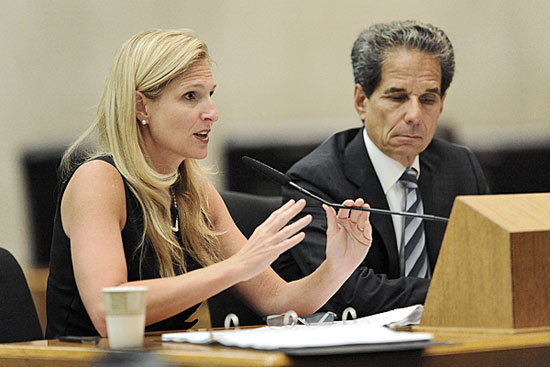
Tamerlin Godley presented findings of the personnel and training portion of the investigation. Bert Deixler, right, discussed the discipline probe.
In a day that will surely be remembered as one of the most difficult in the history of the Los Angeles County Sheriff’s Department, the investigative staff of the Citizens’ Commission on Jail Violence on Friday issued a broad condemnation of the agency’s top management, including Sheriff Lee Baca, for fostering and even encouraging unnecessary violence by custody deputies, while tolerating cliques in their ranks and a code of silence.
Among other things, Baca was criticized for failing “to monitor and proactively control use of force,” turning the responsibility over to top aides “without effective oversight.” One of those aides was Undersheriff Paul Tanaka, the department’s second-in-command, who, according to commission investigators, “discouraged supervisors from investigating deputy misconduct” and undermined the credibility of internal investigators.
Despite concerns expressed by a commander and others about the use of excessive force in the Men’s Central Jail, “key department leaders ignored and failed to address deputy aggression at MCJ,” according to one of six Power Point presentations discussed during a dramatic session of the seven-member Jail Commission, which was created by the Board of Supervisors last October.
Baca, who had earlier said he was unaware of force problems in the jail, strongly backed the panel’s creation and instituted a series of reforms within the department that, by all accounts, have substantially reduced use of force incidents in the dangerous jail system. He also has defended Tanaka, calling him “uniquely qualified.”
The commission’s investigative work was done for free by nearly 50 lawyers from across Los Angeles, some of whom played key roles in earlier law enforcement probes, including the Christopher Commission. They were led by General Counsel Richard Drooyan of Munger, Tolles & Olson. Drooyan, like many of the attorneys he recruited, formerly worked in the U.S. Attorney’s Office.
The findings will be incorporated into a final report with recommendations for reform by the high-profile commissioners, led by Chair Lourdes Baird, a retired federal judge, and Vice Chair Cecil “Chip” Murrary, former pastor of First AME Church. Release of the report is expected late this month.
The findings were divided into six areas of inquiry, included here with links to each of the detailed Power Points. Those areas were: management, use of force, culture, personnel, discipline and oversight.
Some of the findings had been foreshadowed in months of public testimony before the commission from current and retired Sheriff Department employees who said their efforts to crack down on excessive force had been undercut by Tanaka and former Men’s Central Jail Captain Daniel Cruz—both of whom have denied being lax in their responsibilities.
But what was surprising about Friday’s session was the breadth of the alleged failures and the no-holds-barred language used to describe them.
The investigators, for example, said the sheriff “failed to hold senior management accountable,” even though he’s acknowledged publicly that they kept him in the dark about the jail violence problems. Moreover, investigators said Baca has failed to discipline Tanaka, although the sheriff himself has said that his No. 2 had made comments that were “inappropriate and sent the wrong message to department personnel.” There is “no record that senior management has been disciplined, demoted, or faced any consequences,” according to the investigators.
Investigators argued that these lapses at the top helped create a culture in which excessive force against inmates could grow—force that was “disproportionate to the threat posed [to deputies] or when there was no threat at all.”
Some deputies, according to investigators, pitted inmates against each other in violent confrontations and “used humiliation as a tool to harass inmates” through strip searches.
What’s more, according to investigators, the internal review process only encouraged more of the same. They found that, between 2006 and 2011, less than 1% of force incidents were determined by the department to be “unreasonable,” which “casts doubt on the integrity of its force assessments and the reliability of its data.” Only two deputies in the past five years were found to have provided false statements in regard to force reports, a number that raises questions about the adequacy of internal investigations.
Also contributing to the problems, investigators said, were sweeping shortcomings in the areas of personnel and training, including a failure until last year to rotate assignments in the jail. This failure, investigators argued, “contributed to the growth of cliques, a culture of silence and problems of insubordination.” In earlier testimony before the commission, it was disclosed that Tanaka had scuttled one jail captain’s plan to rotate jail assignments, even though it had been approved through the chain of command.
The investigators were also harshly critical of the quality of training and supervision in the jail, saying some of the newest custody deputies have been assigned to the most difficult floors or modules and that the department “fails to adequately monitor” their performance.
Zev narrates “Lincoln” at Bowl
September 6, 2012
The all-American lineup at the Hollywood Bowl Tuesday showcases composers as varied as Bernstein, Gershwin and Copland, the virtuosity of violinist Sarah Chang, and the voice talents of a certain baritone you may have spotted on the L.A. political stage from time to time.
Zev Yaroslavsky, chairman of the Los Angeles County Board of Supervisors, will be narrating Aaron Copland’s “A Lincoln Portrait” with the L.A. Philharmonic at the Bowl on Tuesday, September 11. He joins an illustrious group of narrators who’ve previously performed the work with the Philharmonic, including Gregory Peck, James Taylor and legendary singer Marian Anderson.
It’s Yaroslavsky’s third performance of the work, but his first at The Bowl. “I love the piece. I love the history of it — the time it was written and composed, during the depths of World War II, to rouse the American public with Lincoln’s words,” he said in an interview with the Los Angeles Times. “It still speaks to us today, and to any society.”
The concert begins at 8 p.m. More details are here.
Posted 9/6/12
Long may she wave—o’er Grand Park
September 6, 2012
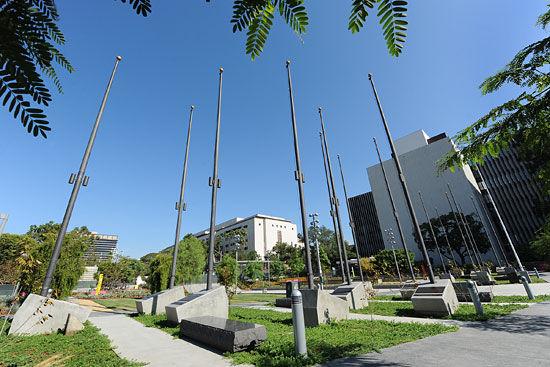
The historic flag court has been moved and positioned for higher visibility and more public space in Grand Park.
The next shiny, new section of Grand Park debuts Tuesday, but its centerpiece has been around for decades—although odds are you’ve never heard of it. Called “The Historic Court of American Flags,” it’s long been flying under the radar.
When the court was first completed in 1971, it featured 18 replica flags dating back to 1774, with plaques describing each one. The minimal landscaping surrounding the display served mostly as a cover for a four-level parking garage below. As far as public visibility, you’d be lucky to see more than a few stars and stripes from the neighboring streets.
Now, as the Grand Park Project gives the 12-acre space between the Music Center and City Hall a dramatic makeover, the flags have been uprooted from their original spot in the center of the park space and arranged parallel to Hill Street and Broadway. This not only vastly opened up the middle of the park’s third block but also gave the flags a more showy location.
Dawn McDivitt, the county’s project manager for Grand Park, said the flag court provides the community with “a space to reflect” on the nation’s—and the county’s—history. She said the county’s Department of Military and Veterans Affairs was consulted on the flags’ relocation and were “very, very pleased” with the results.
The flag court represents an effort by the designers to incorporate the area’s history with its future. A signature feature of the park, in fact, is the renovated Arthur J. Will Memorial Fountain, which, like the flags, was largely invisible to the public until two parking lot ramps were demolished and relocated.
The newest touch was the design of the concrete pedestals in which the poles and plaques have been mounted. Before, everything was cemented at ground level. Architects from Rios Clementi Hale Studios, which designed Grand Park, created the blockish pedestals so that the flags and plaques could be seen more easily, by more people.
The latest section scheduled for opening this week has been dubbed “Community Terrace.” Besides the court of flags, it boasts plants and flowers from all six floristic regions of the world, 24 cherry blossom trees from the Japanese Consulate, and, of course, the park’s movable magenta benches, chairs and tables. Terraced ramps will improve access to the area while offering extra seating capacity for large events once the final segment of the park near City Hall opens on October 6, just in time for the hugely popular CicLAvia to roll through the next day.
The Community Terrace is also home to theVietnam Memorial Monument, which features a bronzed Army helmet from the war’s era. The helmet had been sawed off and stolen twice over the years, so designers upgraded the monument with a threaded steel rod and other security measures to keep any would-be thieves at bay.
The terrace will open with a short ceremony on Tuesday, September 11 at 9 a.m. Bea Cohen, a 102-year-old World War II veteran recently honored by the Board of Supervisors, is expected to be on hand for the event. During the ceremony, the historic flags will be hoisted by veterans from all branches of the military, as well as by fire and law enforcement officials.
Posted 9/6/12




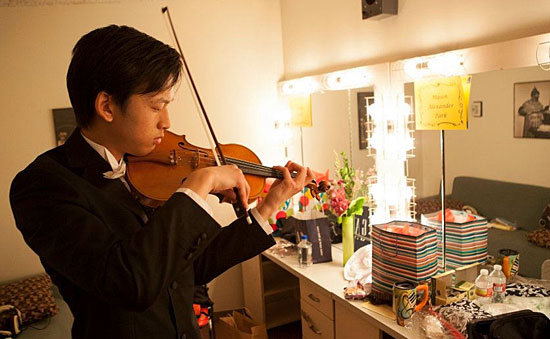
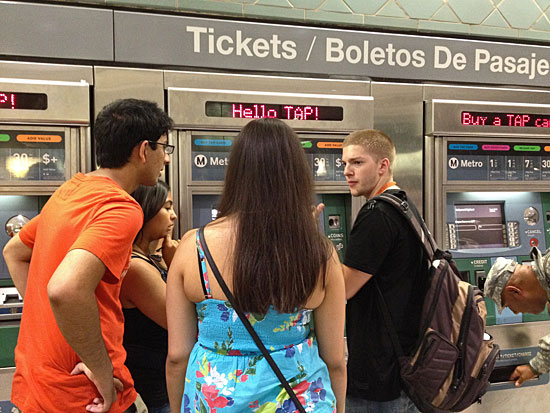
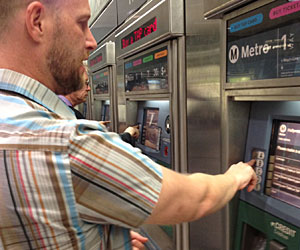
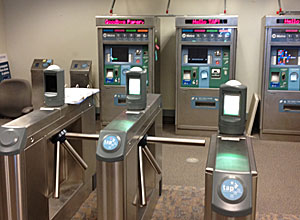
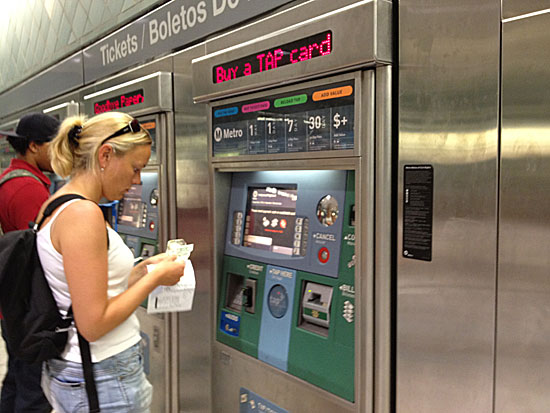
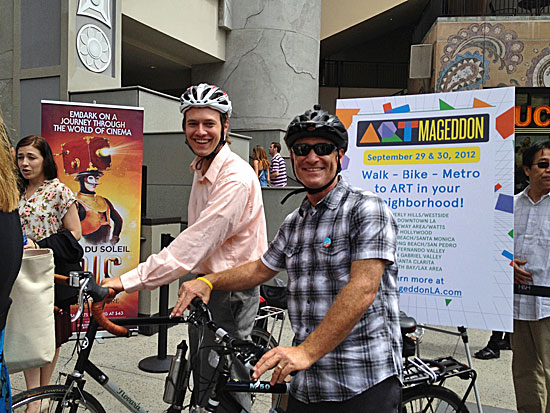
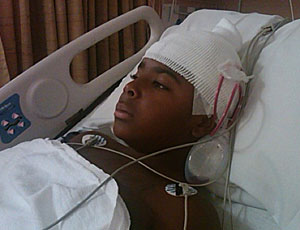

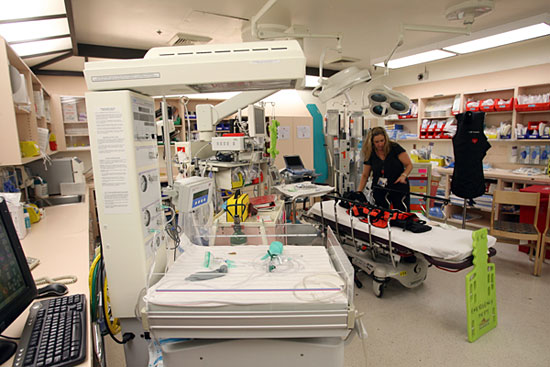

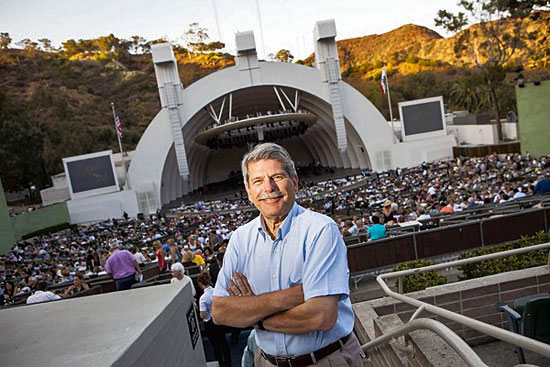
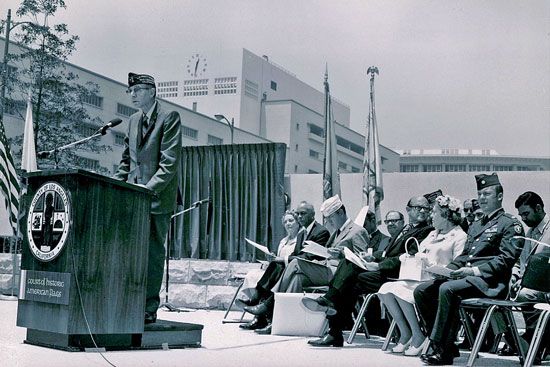





 Check for the latest closure information
Check for the latest closure information








